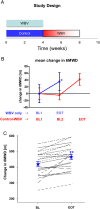Oscillatory whole-body vibration improves exercise capacity and physical performance in pulmonary arterial hypertension: a randomised clinical study
- PMID: 28100544
- PMCID: PMC5529961
- DOI: 10.1136/heartjnl-2016-309852
Oscillatory whole-body vibration improves exercise capacity and physical performance in pulmonary arterial hypertension: a randomised clinical study
Abstract
Objective: In patients with pulmonary arterial hypertension (PAH), supportive therapies may be beneficial in addition to targeted medical treatment. Here, we evaluated the effectiveness and safety of oscillatory whole-body vibration (WBV) in patients on stable PAH therapy.
Methods: Twenty-two patients with PAH (mean PAP≥25 mm Hg and pulmonary arterial wedge pressure (PAWP)≤15 mm Hg) who were in world health organization (WHO)-Functional Class II or III and on stable PAH therapy for≥3 months, were randomised to receive WBV (16 sessions of 1-hour duration within 4 weeks) or to a control group, that subsequently received WBV. Follow-up measures included the 6-min walking distance (6MWD), cardiopulmonary exercise testing (CPET), echocardiography, muscle-power, and health-related quality of life (HRQoL; SF-36 and LPH questionnaires).
Results: When compared to the control group, patients receiving WBV exhibited a significant improvement in the primary endpoint, the 6MWD (+35.4±10.9 vs -4.4±7.6 m), resulting in a net benefit of 39.7±7.8 m (p=0.004). WBV was also associated with substantial improvements in CPET variables, muscle power, and HRQoL. The combined analysis of all patients (n=22) indicated significant net improvements versus baseline in the 6MWD (+38.6 m), peakVO2 (+65.7 mL/min), anaerobic threshold (+40.9 mL VO2/min), muscle power (+4.4%), and HRQoL (SF-36 +9.7, LPH -11.5 points) (all p<0.05). WBV was well tolerated in all patients, and no procedure-related severe adverse events (SAEs) occurred.
Conclusions: WBV substantially improves exercise capacity, physical performance, and HRQoL in patients with PAH who are on stable targeted therapy. This methodology may be utilised in structured training programmes, and may be feasible for continuous long-term physical exercise in these patients.
Trial registration number: NCT01763112; Results.
Published by the BMJ Publishing Group Limited. For permission to use (where not already granted under a licence) please go to http://www.bmj.com/company/products-services/rights-and-licensing/.
Conflict of interest statement
Figures


References
-
- Galiè N, Humbert M, Vachiery JL, et al. . 2015 ESC/ERS Guidelines for the diagnosis and treatment of pulmonary hypertension: The Joint Task Force for the Diagnosis and Treatment of Pulmonary Hypertension of the European Society of Cardiology (ESC) and the European Respiratory Society (ERS). Endorsed by: Association for European Paediatric and Congenital Cardiology (AEPC), International Society for Heart and Lung Transplantation (ISHLT). Eur Heart J 2016;37:67–119. 10.1093/eurheartj/ehv317 - DOI - PubMed
Publication types
MeSH terms
Associated data
LinkOut - more resources
Full Text Sources
Other Literature Sources
Medical
